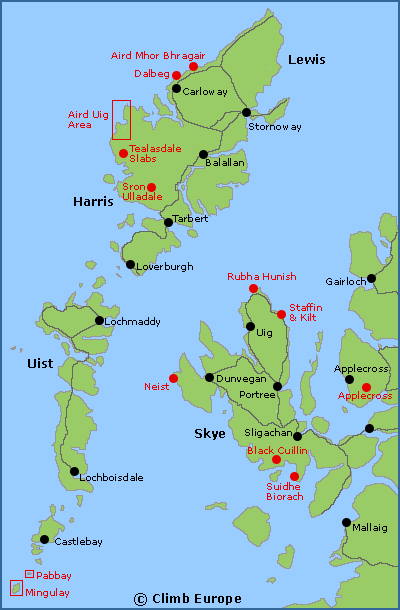Rock climbing on the Isle of Skye and the Outer Hebrides
The north-western Islands of Scotland offer some fantastic climbing particularly on the Isle of Skye, Lewis and Harris, plus the remote and uninhabited islands of Pabbay and Mingulay.
Isle of Skye rock climbing
There is so much climbing on the Isle of Skye that it requires two definitive climbing guidebooks to cover it all. The climbing is essentially split into 2 distinct types; mountain multi-pitch climbing on the famed Black Cuillin range; or sea cliff climbing on the west and north coasts.
The rock of the Black Cuillin is of a very rough black-coloured volcanic type called Gabbro, and is said to be the roughest and best in the UK. There are numerous crags within the Black Cuillin, with Sron Na Ciche being the largest and best cliff. It also has one of the shortest approaches and is therefore is very popular. This expansive north-west face overlooks Coire Lagan and is 500m wide, rising to almost 300m high. There are a superb range of multi-pitch routes of every grade, and most are quick drying.
A traverse of the main Cuillin Ridge is arguably the best mountaineering route in the British Isles. It is 12km long, consisting of continuously challenging terrain and summiting 11 Munros, along with sections of technical climbing (up to VD) and abseiling. It is a massive undertaking that has repelled many parties who have underestimated the physical, but also the mental effort involved in tackling the 4,000m of ascent and descent involved.
Map of the main rock climbing areas on Skye and the Outer Hebrides

The sea cliff climbing on Skye is found on the west and north coasts. On the north Trotternish peninsula there are 2 areas. The first being Kilt rock and Staffin that are an impressive selection of columnar basalt sea cliffs. These mainly non-tidal cliffs have routes up to 50m long. Further north is Rubha Hunish that also has a good selection of routes with some of these being 80m long. On the west Duirinish peninsula are the dolerite crags of Neist Point. Here there are over 400 single pitch routes across a wide range of grades that are located on a mixture of tidal and non-tidal crags. Further south is the sandstone crag of Suidhe Biorach. The routes here are single pitch up to 30m long mainly in the VS to E4 grade range. There are also numerous sea stacks off the coast of Skye that offer some adventurous rock climbing, plus plenty of bouldering areas as well.
The two definitive rock climbing guidebooks for Skye are called Skye sea-cliffs and outcrops, and Skye – The Cuillin, with both being fully modern guidebooks with colour photo topos.
The Scottish Rock Volume 2 guidebook and the Wired Scottish Rock Climbs guidebook both describe a selection of the best routes on Skye.
There are also a couple of excellent guidebooks for the Cuillin Traverse; these are the Skye's Cuillin Ridge Traverse Guidebook, and the Cuillin Ridge Topo Guidebook.
Lewis and Harris rock climbing
The climbing on Lewis and Harris is on perfect rough Lewisian Gneiss rock containing swirls of pink quartz, and is one of the World’s oldest rock types.
The main climbing area on Lewis is around Aird Uig on the western side of Lewis, where there is an extensive range of near-roadside sea cliffs for all abilities, with many routes over 40m long. Similarly, isolated sections of the coast further north, such as Dalbeg and Aird Mhor Bhragair, have produced a great range of routes of all standards. In the nearby hills the Tealasdale slabs on Griomaval and the remote-feeling Creag Dudh Dibadale give excellent long climbs up to 200m long.
On Harris, the famed Sron Ulladale presents the steepest and most impressive crag in Britain, hosting some excellent lower grade routes in addition to the highest concentration of long hard extremes (E5 to E7) in the country that are up to 200m long.
The definitive rock climbing guidebook for Lewis and Harris is called the Outer Hebrides Rock Climbing Guidebook. Published in 2018 it is a fully modern guidebook with colour photo topos. The Scottish Rock Volume 2 guidebook and the Wired Scottish Rock Climbs guidebook both describe a selection of the best routes on Lewis and Harris.
Pabbay and Mingulay Rock Climbing
South of Barra are the 2 uninhabited islands of Pabbay and Mingulay that rank as some of the finest adventurous rock climbing in the UK. Despite the difficulties of getting to these islands (5 hour ferry and chartering a local boat), their remoteness and difficulty of access only adds to their charm. Here you will have complete solitude, as there are no comforts other than those taken onto these islands by boat.
Pabbay and Mingulay offer remote adventurous sea cliff trad climbing with many 100’s of routes on perfect weathered Gneiss rock. The routes are between 20m and 120m in height, across a wide variety of grades, with many classics between VS and E5. Both islands offer a varied selection of crags mainly along their southern and northern coastlines, with the vast majority of the routes requiring an abseil approach.
The definitive rock climbing guidebook for Pabbay and Mingulay is called the Outer Hebrides Rock Climbing Guidebook. Published in 2018 it is a fully modern guidebook with colour photo topos. The Scottish Rock Volume 2 guidebook and the Wired Scottish Rock Climbs guidebook both describe a selection of the best routes on Pabbay and Mingulay.